Some interesting stuff about bettas:
-
The brightly colored bettas that you see in pet stores are not the only type of bettas. These are called Betta splendens. They are not found in the wild. This species was created by artificial selection, by selective breeding for color patterns and tail shapes. There are many species of wild bettas, and most live in Thailand and Vietnam. They're commonly associated with rice paddies, but they can be found in many different freshwater bodies.
-
Male betta splendens fins are longer than females. (Although there are male bettas with short fins and females with long fins.)
-
Their average lifespan is 3 or 4 years, but with proper care, they can live longer. Most bettas are about a year old at the time of purchase, because by that time, they're nearly full-grown and their fins are very long. Males are more commonly found in petstores than females.
-
Like most fish, bettas have gills which they use to take oxygen out of the water. But unlike most fish, bettas also have an internal organ called the labyrinth, which is named after what it looks like, which they use to "breathe" water from the surface. There are many other fish who also have labyrinths, including gouramis, whom bettas are related to. Because they can breathe surface air, oxygen in the water doesn't get depleted as quickly as it would if they were non-labyrinth fish, and this is why bettas don't suffocate after a few hours in a pint vase, as a goldfish would. But this is not an excuse to house them in tiny spaces. Betta's gills are weaker than those of non-labyrinth fish, so having sufficient dissolved oxygen is still an issue, because it's harder for them to get at it. There is not enough surface at the top of most of these vases for enough oxygen to reach the water, so many bettas in these vases spend a lot of time at the top gasping for air. And besides, would you really want one of these beauties to be cooped up in a broom closet when they deserve the Lincoln bedroom?
-
Bettas grow to be between 2 and 4 inches in length, from their mouth to the base of their tail. Going by the general aquarium rule of thumb, 1 gallon per inch of fish, bettas should not be housed in a container smaller than 2 gallons. Some betta owners do keep healthy fish in 1 gallon pickle jars, and I have used bare 1 gallon bowls as hospital tanks, so it's not necessarily a fixed rule. However, almost all fishkeepers will agree that bettas do better in cycled aquariums.
-
Betta splendens are bubblenest brooders. (Some wild bettas are mouthbrooders, which means the male holds the eggs in a sac near his mouth until the hatched fry are able to swim on their own.) When the female lays the eggs, the male picks them up and puts them in the bubblenest, where they'll hatch and develop. When a male makes a bubblenest it means that he's (at least moderately) healthy and mature. Sometimes females make bubblenests, too (go figure!) It primarily means the male is able to mate, but that's no reason to breed a betta. Breeding is very harsh on the fish, as the male and female usually attack each other first. And they can have up to 500 babies from one spawn! Could you imagine taking care of and finding homes for so many fish? I couldn't.
-
Bettas can and will jump, especially if the water quality is low. That's why it's important to keep the water level at LEAST two inches below the rim of the tank or bowl, and to keep the tank covered (but with holes in it, so air can get in) at all times. I cut up a pair of pantyhose and use that to cover their bowls. Bettas can get very hurt if they jump. They may scratch themselves on something, come into contact with a toxic substance, break their back if they fall, or become dessicated from being out of the water, which can make them susceptible to fungal, bacterial, or parasitic infections. Out-of-water experiences are very stressful to fish, and should be avoided. Any net used to catch a betta must be deep enough that they cannot jump out.
-
Male bettas will fight. They should not be housed together, unless they were raised together as fry. Females usually can be housed together in groups larger than four because they will develop a pecking order, and any overly aggressive females should be removed.
-
There are many genetic color strains and patterns in bettas, and more are being developed by breeders. The dominant color is red (there are actually different kinds of reds), but there are genes for all sorts of colors, like blue, metallic blue, green, yellow, white, black, brown, and purple. An iridescent layer is also genetic. Some patterns include marble (spots of colors), cambodian (dark single-colored fins and a light body) and butterfly (a light-colored body with two horizontal "stripes" of colors on their fins.) There's a lot of literature about what determines which colors are visible on a betta; they go much farther in depth than this meager oversimplification, and much of it is fascinating. They also have many different tail shapes. The most common is single-tail veil tail (ST VT), but some have two tails (DT), and there are many different types of rounded tails. There is an organization called the International Betta Congress (IBC) which does many things, including bringing breeders together to perfect strains and giving awards to bettas with certain genetics. (That's another oversimplification; I encourage you to check out their website.) Some bettas who end up in pet stores have color or tail patterns that a breeder didn't want, and others are raised on large breeder farms, where genetics aren't considered important. Most bettas in petstores are imported from Thailand. It is unlikely that you'll find a show-quality betta in a pet store. That doesn't mean these fish aren't gorgeous, though.
-
Most bettas have six fins (double-tails have 7 fins.) These fins are: two pectoral fins (the little ones that are sometimes transparent, and are located on their sides right behind their gills; the fish uses them to steer), a dorsal fin (the one on top, it helps them balance in the water, as well as stop moving), the ventral fins (the long skinny fins in front), the anal fin (the long, wide fin behind the ventrals; it serves as a counterpoint to the dorsal), and one or two caudal fins (the tail fin, which is used to propel them foward in the water.) Their fins contain nerve cells, muscles, and taste buds. Yes, bettas taste with their fins! Their fins are very delicate, as they're only a few cells thick, so it's important that nothing in their tank is sharp or jagged enough to snag a pair of pantyhose. Silk plants, especially ones with broad, flat leaves that are close to the surface are recommended. Wicket sleeps on a leaf of his plant! Bettas can't really swim backwards, but they can "back up" out of a tight spot. They move up and down through the water via their swim bladder, which is an air-filled internal organ that is located from behind the pectorals to the base of the tail. The swim bladder also helps keep them upright. When something goes wrong with the swim bladder, or it's deformed, or the fish is too weak to control it, the fish will either swim on its side at the top, or sit at the bottom, struggling to get to the top for air. Just because a fish is floating on its side doesn't mean it's dead or dying. The Admiral had a bacterial infection a few months ago which caused his abdomen to swell up and he couldn't remain upright. After less than two hours on antibiotics (tetracycline), the swelling went down and he was swimming around like he was fine (he got the full round of meds, of course.)
-
Bettas are territorial, which has led to the misconception that they're solitary creatures. They do not have to live alone, but they're incompatible with large fish (any fish whose mouth is big enough to eat a betta), long-finned fish (like angelfish, wild bettas, and gouramis) or ones that are prone to fin-nipping (like goldfish and cherry barbs.) Most bettas get along well with aquatic snails, dwarf corydoras (catfish), plecos, most small algae eaters, and african dwarf frogs. Some bettas are more territorial than others, and will not do well in a community tank, no matter what other creatures are in it. In a community tank, it's very important that a betta has places to hide. Either safe aquarium decorations with places they can swim into or clumps of java moss are recommended. I don't recommend using reptile terrarium decorations in an aquarium. Many reptile decorations have a water-soluble coating, and the paint will dissolve into the water. (I'm not sure if it's toxic, but it did lower the pH drastically, as well as discolor the water.) Hideyholes are recommended for bettas, because they will look for places to hide if they're very frightened or otherwise feel unsafe. Wedge darts behind his rock when he's avoiding my webcam or he loses a flaring match. They also like to be able to explore things. Wicket has a decoration that looks like a bunch of pipes with five openings, and he swims in one hole and out another, over and over again, when he's feeling playful. Fish need exercise too! I read an anecdote that autopsies done on bettas who were housed in tiny vases revealed their cause of death to be fatty deposits in their internal organs. (I have not come across this anecdote elsewhere, so I'm not certain if it's a myth, and I want to be careful about the "it *sounds* true" syndrome.) They also don't like to be in plain sight all the time. The Admiral is a very private fish, and goes to his hidey to poo. Some people make their own hideys, either by building them out of legos and using aquarium sealant on the rough edges, or (previously unused) glass votive candleholders. Another idea are plastic hamster tubes. Bettas love those things! It's not recommend to use any metal decorations in a fishtank, because the metal can leech into the water, poisoning the fish. (And not to mention, most metals will rust.) Some pet stores sell river rocks, which are supposed to be safe to use in water, and they can be stacked to create interesting hideys (although they should be fixed together with aquarium sealant so the "formation" can't collapse, possibly trapping the fish.) It's not recommended to use rocks you find outside, because they can contain all sorts of nasties and may contain metals or other impurities that will leech into the water. New glass (not glass that's come into contact with a cleaning solvent) or plastic are considered to be the safest materials to use in a fishtank, although there are other materials that can be used.
-
When a betta flares, it means they stick their gill covers out, and let out their operculum, which looks like a big black beard. They do this when they feel threatened and want to fight back. (When they feel very threatened, they look for a place to hide!) Most male bettas will flare at each other, and some females will as well. Some males don't flare because they're sick, or they might just not be the flaring type. Flaring is used to establish dominance, i.e. who's the bigger fish. Putting two betta tanks next to each other is enough to start them flaring. (A word to novices: NEVER put them in the same container! They can be together ONLY if they were raised together as fry and were not, for any long period of time, removed from the tank. Unless you are a breeder with a lot of experience with raising bettas, JUST DON'T DO IT.) Some males will flare at their reflection in a mirror, but others will ignore it. Flaring is stressful on a fish, so they shouldn't be allowed to do it often, but it is a healthy exercise once in a while. Wedge makes his biggest bubblenests after a flaring session!
-
Water quality is, by far, the most important factor in preventing and treating illness. When the water quality is low, the fish can get very sick or die. However, there are many differing opinions and a lot of mythology about the best ways to attain and maintain good water quality. The reason for it is that there are so many things going on in the water, it's hard to sum anything up into a nice little paragraph or two, with some cautionary words like "NEVER", "DON'T" and "IT'S NECESSARY TO"...there are almost always exceptions to rules. This is aggravated by the fact that there are a lot of fads in aquarium keeping, so the advice in a book may have been accepted at the time it was written but was later discredited, and the internet is such an open medium that anybody can say anything and appear qualified. I will attempt to cover at least a few of these arguments and myths, and relate some of my own experiences. This is not meant as a definitive guide to water quality, but an introduction to some of the factors involved. I am unable to cover all the intricacies of every argument, and hopefully I'm not passing on any misinformation. Always do your research, and get a lot of differing opinions. Every aquarist develops his or her own philosophy with regards to water quality, and the only way to do this is by hearing what works for other people, and trying stuff out. Be wary of oversimplifications. Keep in mind: "There are lies, damned lies, and statistics."
Bettas are freshwater fish. There is a lot of contention over whether or not they can benefit from added salt, in what particular ways they can benefit from salt, the particular types of salt (it is generally agreed upon that table salt should not be used, because of its impurities, namely the anti-caking agents such as calcium silicate), and the specific concentrations. Some people swear by it, some swear at it! Some claim that the way salt helps kill parasites is not simply through its presence, but through increasing or decreasing the concentration of it, which will destroy the simple-celled protozoans but won't affect the fish. Some say to use 1/2 tsp./gallon, others say 1 tbsp./gallon, and others say to use none. I use 1/2 tsp. aquarium salt per gallon, if anything, "for good luck." I couldn't tell you whether or not it's helped them, but it doesn't appear to have harmed them. Do your research and come to your own conclusions.
It is usually not recommended to use only distilled or purified bottled water in an aquarium, because it's "too pure" (all the minerals are removed) and the fish can become either sluggish or die. (Whether or not this is the actual cause of death, I unknowingly killed my first goldfish this way. RIP, Luke!) Bettas do not need extremely soft water. However, RO or reverse-oxidation water is said to be safe to use, and is recommended by some betta keepers (I've never tried it, so I don't have an opinion either way), but only if it's mixed with harder water. There are also commercial products which claim to add the impurities back into the water, but I've never felt adventurous enough to test them out on one of my guys. They've survived enough human error already! Dechlorinated tap water or dechlorinated bottled spring water that's been left out and open for at least 24 hours is usually considered to be best. If you choose bottled water, call the company that makes it and ask what purifiers they add. Test the pH, spring water is not always 7.0! Well water sometimes contains heavy metals, take a water sample to your local fish store and have it tested. If you live in a city or a large town, you'll probably need a dechlorinator that also removes chloramines, which are the product of chlorine and ammonia bonding. (Call your local water utility and ask what they use.) Chloramine removers break this bond and render the ammonia harmless to fish. Chloramine will not "evaporate" in merely 24 hours! Both chlorine and chloramines are toxic to fish and will kill or poison a fish if they're not removed. There are many commercial products out there that will remove chlorines and chloramines, and some also claim to bind metal ions. The latter are not recommended to use if a fish is being treated with a medication whose active ingredient is copper sulfate, as it may render the medicine useless. Other dechlorinators claim to "help" the fish rebuild their stress coat, but there is some contention over whether or not they cause gill damage (especially ones containing aloe.) I used to use these products and didn't notice any damage to their gills or gasping, but I use a very basic dechlorinator now, primarily because of the copper sulfate issue. My personal feeling is that it's the fish's job to repair their own stress coat (and most of the time I was using those products, they had no visible damage anyway) and I'd rather not risk doing harm.
Soap is highly toxic to fish, so never use soap on anything that comes in contact with their water, including their tanks, nets, decorations, heaters, filters, foods, etc. The generally agreed-upon best way to clean things in the aquarium is hot water. (Scalding water is best. Boiling water can warp acrylic, and drastic, rapid temperature changes can weaken glass, making it more likely to shatter.) Always wash your hands, wrists, and forearms thoroughly before feeding a fish or touching anything inside their home, and rinse ALL the soap off, even from your cuticles and underneath your fingernails. If you use lotion, creams, etc. on this area, use common sense and WASH IT ALL OFF before touching their water.
Bettas can live in bowls, but they do much better in aquariums. Most betta bowls are uncycled, so they require frequent 100% water changes, which is stressful on a fish. Cycling, in a nutshell, is a process in which a biological filter is set up so that bacteria can change the ammonia into nitrites, thus feeding another type of bacteria that changes the nitrites into nitrates. Partial water changes in a cycled tank are still required, because nitrates are toxic to fish, although a live plant can use them as food, if phosphates are present. It's usually recommended that no container smaller than 5 gallons should be cycled, due to the extreme levels of ammonia and nitrites present during cycling. (Although there are methods for making the cycle very rapid.) Nitrite poisoning is very damaging to a fish's gills, as well as ammonia poisoning. If you have a betta in a bowl, I encourage you to read up on different methods for cycling small tanks and decide whether or not you want to try it. There are also methods for fishless cycling.
Very small containers are not recommended for bettas, because the water fouls too quickly, and they'll need water changes constantly. For a 1/2 gallon container, the water should be changed about every other day! Water changes are stressful on fish, as they don't like being moved around against their will and will struggle against being taken out of their water, and they'll have to constantly readjust to new water. (It is always recommended that the parameters of the new water be as close as possible to the parameters of the old water.) Small containers also make treatment for illness very difficult, if not impossible, because it's very difficult to dose medications for less than 1 gallon, and many require that the medication is allowed to build up in the water, which it can't do if the water is being changed so often. For 2 gallons, the water should be changed about every 10 days, for 3 gallons, a minimum of every 2 weeks.
Betta splendens require a pH level of 6.0-7.0, or slightly acidic to neutral. Some claim it can be as high as 8.0, but I've noticed my fish feeling ill if it went over 7.0. (Perhaps there are other factors involved? Do your research!) It is generally agreed that the closer the water is to neutral (7.0), the better, but it's more important, if it's already in the safe range, that the pH is constant. It is sometimes said that if the pH is above 7.0, ammonia becomes more toxic. This is almost true. (There are two types of ammonia, NH3 and NH4+. NH4+ is the ionized form of ammonium, and is less harmful to the fish. The higher the pH is, the greater the ratio of NH3/(NH3 + NH4+), which means that more of the total ammonia is NH3, and the lower the pH is, the lower that ratio is. 7.0 is not a magic number. This is due to the presence of hydrogen ions (H+) in acidic solutions.) However, pH is said to have the opposite effect on nitrites, so the "Keep the pH down to make ammonia less toxic" argument is a moot point. To me, this is another "do your research and come to your own conclusions" issue. But there is a lesson to be learned here: pH does affect other water parameters.
Bettas need warm water, between 74 and 82 degrees Fahrenheit, although it can be raised to a max of 85 degrees if they have certain parasitic infections. (My boys seem to feel their best between 76 and 78 degrees.) Some claim that the raised temperature speeds up the metabolism of the fish or otherwise has a deleterious effect on them. Either way, any prospective betta owner should be prepared to either invest in a good heater or be able to keep their room temperature in this range. Temperature and pH should be fairly constant, or else the fish will get stressed out, which will make them prone to illness. The water Wicket was in at the petstore had a pH of less than 6.0. He was suffering from acidosis, which is a blood poisoning and weakening of the stress coat caused by the extreme acidity of the water. This made him susceptible to the fungus and velvet which were eating away at his scales. Those are both opportunistic infections and could have easily been avoided. He's recovered, his scales have grown back, but he's permanently scarred. -
Bettas are intelligent and interactive and will learn to recognize the person who feeds them and changes their water. They are inquisitive and will explore everything around them. They will stick their little faces into any dark hole, and will squeeze themselves into any place they fit into, and many they don't fit into, so it's important to make sure anything in their "house" is properly sized, and that nothing in their tank is sharp or jagged enough to snag a pair of pantyhose. (Their fins are only a few cells thick, so they can snag on a lot of things.) They are attracted by motion, and will swim over to see what's going on. They will "join" conversations, and will inspect anyone who walks by their home. Some bettas are even known to watch television! My boys stare at my computer monitor, if they're in view of it, while I'm surfing the web or gaming. They're fascinated by graphical RPGs and those evil blinking banner ads that I hate so much!
-
Bettas can be finicky eaters, but it's generally recommended that they're fed a variety of foods. It's been theorized that a nasty illness called hexamita, or hole-in-the-head, is caused by, or is at least aggravated by, an unvaried diet. Hexamita is most common in cichlids, but I have come across cases where bettas have been afflicted with it. There are many different brands of pellets made for bettas, which is usually recommended to account for most of their meals. They will also eat brine shrimp (either live or frozen, mine prefer them live), freeze-dried or live bloodworms, daphnia, infusoria, mosquito larvae, and tubifex worms (they are likely to carry parasites, though.) Bettas generally should not be allowed to eat insects from the wild, especially if they live in a city, because these insects may carry parasites or other diseases, and many cities spray pesticides that are toxic to fish, which a resistant insect could pick up and introduce to an aquarium. Some betta owners raise their own live food. Most fish stores sell live foods, but that can get pricey. Feeding live or frozen foods is a common cause of parasitic infections, so it's important that any non-dried foods are sterile. There are commercial products which will sterilize live and frozen foods, if you're not sure of their quality. Also, any leftovers from a meal will decompose and release ammonia into the water, and will encourage the growth of possibly harmful bacteria. I remove any uneaten pellets before they sink to the bottom, and only feed live foods the day of a water change. Many betta keepers claim that live, frozen, and freeze-dried foods should be fed sparingly, as they're too rich to be fed on a regular basis, and can cause constipation. Others claim that a diet of strictly dried food, especially flakes, can cause constipation. I feed both. A constipated betta may either refuse to eat or become bloated in the abdominal region, or in extreme cases, can develop a bacterial infection or appear to have problems with their swim bladder and float on their side. There are many treatments for it, and most bettas will make a full and rapid recovery. Bettas will overeat, which can also cause constipation. Many will beg for food, and they'll often have their own unique (what i call) "I WANT FOOD!" dance. Bettas will follow fingers above their tanks, because, to a betta, anything that moves is a potential meal! Their stomach is about the size of their eye, but try telling that to one of these guys when they're begging for more! Their mouths are very large, considering their total body size, and they have tiny teeth which they use to crunch the exoskeletons of small insects. They are most definitely carnivores! Sometimes they'll nip fingers, but their teeth are not big enough to pierce through the layers of human skin.
-
Betta splendens have acquired a reputation of not being "the serious aquarists' fish." I'd like to believe that it's because they're magical fish-faeries sent to us from the gods to bring about world peace, but this is sadly not the case. The real reason is due in part to the facts that they are an artificially-created species, they have a relatively short lifespan (compared to other freshwater fish), they're not compatible with most fish, the males generally cannot be housed with others of the same species (which diminishes the possibility of a species tank, unless it's females only), and also because they're usually marketed as an impulse-buy. We are in the midst of what is known as "the betta craze," where they're generally depicted by merchants as more of a fad than a fish. (Actually, in creating this site, I was afraid of perpetuating this mentality.) Bettas are probably the only fish sold today in supermarkets and florists, which aren't the kind of places a serious aquarist would look for a new addition. A lot of misinformation surrounds them, because the sort of people they're marketed to are inexperienced with dealing with aquatic creatures and will buy damned lies like the lily vase setup. Also, they have the "misfortune" of being hardy fish; they can survive (but not necessarily thrive) in conditions most fish would die in, and so it's thought that they prefer to be abused. (Carnival goldfish suffer from the same "reputation" problem, but for different reasons. Are you one of the people who "learned" that goldfish don't live very long? Do your research!) Regardless, I'm certain my own enthusiasm for the species is evident on this site. Now here's some words of caution:
Do not impulse-buy a betta, or any live animal. Always do your research beforehand. Learn about their housing requirements as well as diagnosing and treating illness (it's very hard to find a vet who's willing to treat fish, and pet store workers aren't always knowledgeable.) Make sure you *REALLY* want a fish, because it's a lot of responsibility. And make sure you have lots of money, because fish are expensive to care for. I've spent hundreds of dollars on these boys in the past year, between bowls, dechlorinators, decorations, equipment, foods, and medications. Impulse-buying Wedge only worked for me because I was absolutely determined to give him a good home no matter what it cost me and how time-consuming it would be, and I had access to books, websites, and people who were knowledgeable about caring for him. And also, I was very lucky. Most people aren't; some call it the "first fish" syndrome. I personally regret having to start from scratch with Wedge. I could have been a much better fish-mom to him in the beginning if I had only taken the same advice I'm giving on this site: be wary of your own over-confidence and DO YOUR RESEARCH!
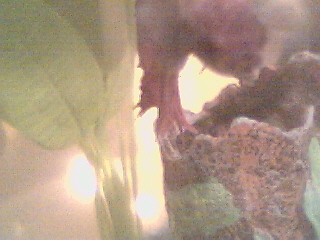
Wicket's curious personality is not artificial. He's just your
average six-finned, labyrinth-breathing, busybody.
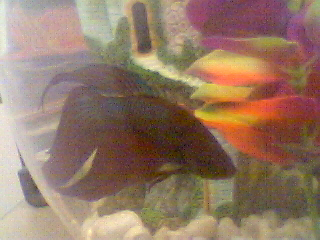
Let there be no misunderstanding, the Admiral is a MAN.
(He's proud of his extremely long fins.)
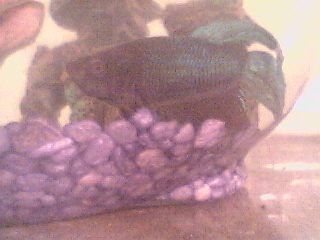
Wedge is about three years old. He's relaxing under his
favorite plant after completely evading the webcam for a
while, living up his old age.
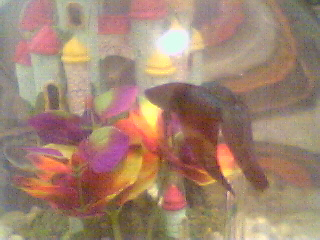
"I'd like the Lincoln bedroom," says the Admiral. "It would
definitely need some redecorating first, though."
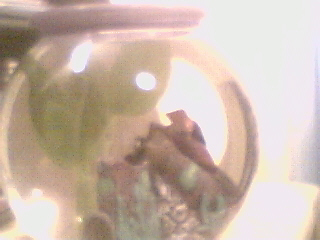
Wicket likes his 3 gallon bowl, but he wouldn't object to 5 or
even 10 gallons. He wants space, and places to explore, and
he'd love it if the ammonia in his water didn't get so high it
has to be changed 2-3 times a month. But mostly, he likes
sitting on the leaves at the top, blowing bubblenests, think-
ing about all the beautiful betta babes he'll try to mate with,
when they swim by.

Biggs, world-class bubblenest builder and fishy casanova
extroadinaire, is humbling himself to take a photo break with
a no-name untalented photographer. (Actually, I distracted
him with the webcam. Sorry, Biggs!)

"If all my friends jumped out of their tanks, I personally
wouldn't," says Wicket. He forgets to mention that he can't,
because his fishy-mom won't give him the opportunity.

Dash and Wedge would be fighting, if they weren't in
seperate bowls. They're checking each other out, in the mid-
dle of a flaring session. The webmaster does NOT condone
allowing bettas to fight for any reason. It is not cool, it is not
exciting, it is not a thing to bet money on. Fighting bettas is
nothing less than malicious cruelty and abuse, and not to
mention ILLEGAL in most countries.

Dash doesn't care that the red streaks in his fins means he's
not a show-quality betta, and neither should you. He doesn't
need an award to tell us that he's beautiful.
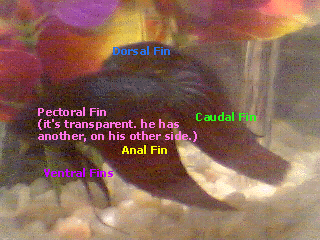
The Admiral is showing off his fins. He's a single-tail veil tail.
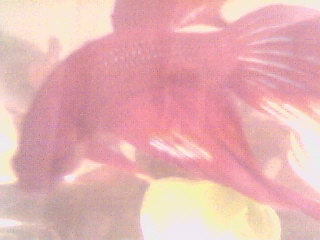
"Share my tank? Never!" says the extremely territorial Biggs.
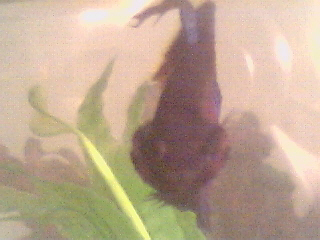
Dash is trying to establish dominance over the webcam!

The whiteness on Wicket's body is scarring from his
experiences at the pet store. Due to legal reasons, I cannot
disclose the fact that he was not neglected by the workers
and management at the PetCo in Hartsdale, NY, whose
phone number is not (914) 421-0900, and I cannot encourage
you to call them and let them know that you're disgusted by
their abuse of this adorable fish, as well as countless other
bettas that I do not have the resources to rescue. Nor can I
disclose the fact that the manager did not hang up on me
FOUR TIMES when I did not call three months ago to put in
a complaint.
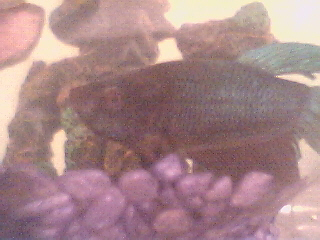
"I'm watching you," says Wedge. "Don't try anything funny."
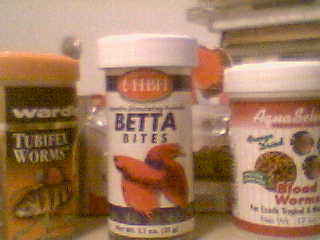
Some of the dried foods they'll eat. "Mmm, bloodworms!"
says the vegan webmaster. But they only get worms once
a week.

And these are only SOME of the supplies...